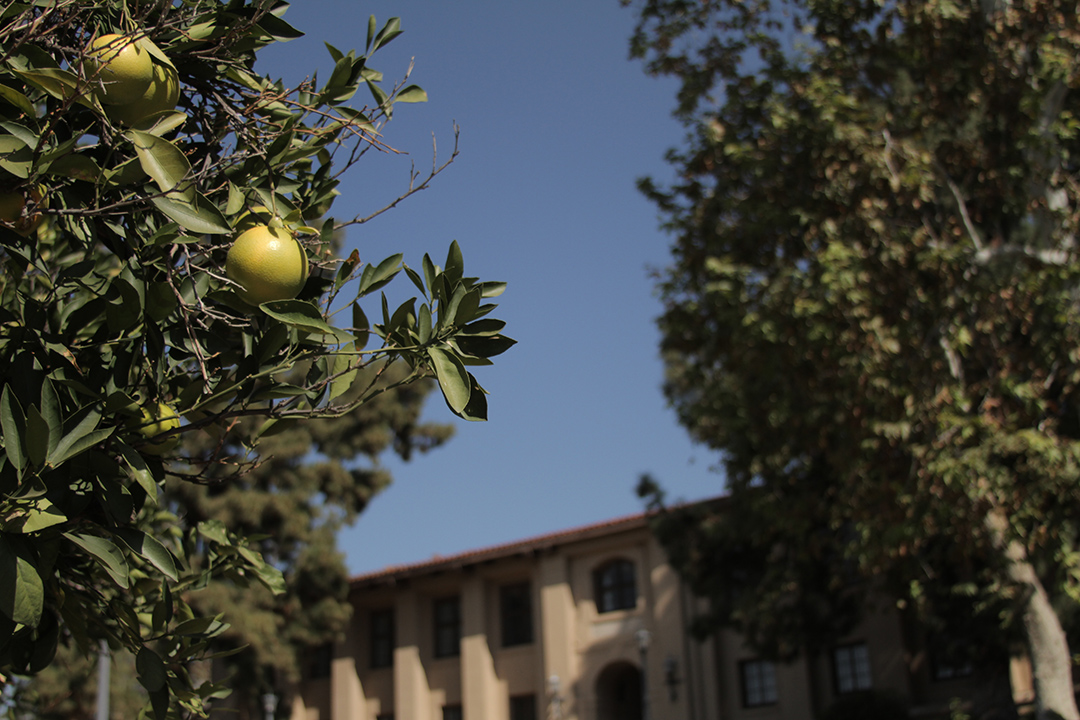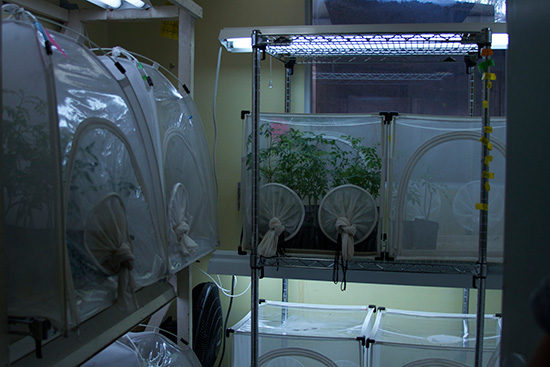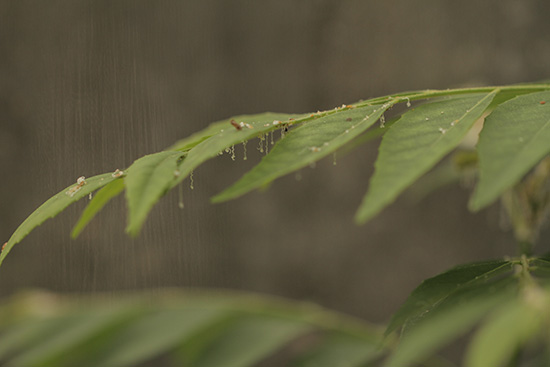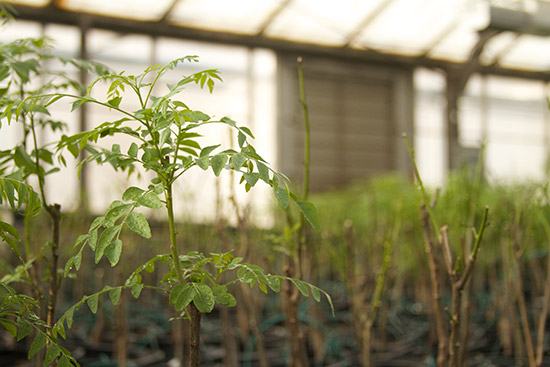
The Clock is Ticking for the California Citrus Industry
A lab-coated man shuts the door to a short hallway and locks click behind him. The walls of the hallway are black, the ceiling is black, the floor is black. The only source of light is from an LED bulb affixed in the nook where the wall meets the ceiling. The inside of the light fixture is covered with sticky paper. The man's lab coat is embroidered with the name 'Mark Hoddle.'
Hoddle's hair is shorn close to his head and his blue eyes stand out unnaturally in the dimness. He pulls open the door at the opposite end of the hallway to reveal an identical black space on the other side. Everything is designed to keep the creatures here from escaping, he says. This whole floor of the building is a maze of dark, segmented stretches of corridors. The air circulation is designed to flow inward. Any item brought inside has to be fumigated before it goes back out.
As Hoddle traverses the maze, he opens a few of the doors along the hallway. The spaces inside are brightly lit and filled with little clear plastic tents on wireframe racks. Little potted trees are growing inside the tents and from some of their leaves dangle tiny spirals of sugar.

It's a scene straight out of a low-budget Syfi Channel movie except for how it isn't. In reality, this is the third level of the Insectary and Quarantine Facilities at the University of California, Riverside. Mark Hoddle is a biological control researcher who imports exotic parasites and brings them here, to what he says is one of the largest quarantine facilities in the United States, for study.
Hoddle's work revolves around the uphill, prolonged battle against invasive species, which are basically any non-native plants, animals or insects that causes economic or environmental damage. Think kudzu, fire ants or zebra mussels. Biological control is the strategy of fighting back against invasive species by purposefully introducing their natural enemies to wherever it is they've invaded.
That may seem counterintuitive, introducing an invasive species to fight another invasive species. But Hoddle, and other researchers across the country, view biological control as a vital part of their toolkit. In the quarantine facility in Riverside, the target is the Asian citrus psyllid, a major threat to the California's $2 billion citrus industry.
Psyllids are tiny insects. Hoddle's team grows this particular invasive type on the potted plants in the plastic tents. The best way for the untrained eye to spot them is to look for those little spirals of sugar, which is what they excrete as they chew on the leaves.

Just like a mosquito bite doesn't amount to much for a human unless it's carrying something like malaria, Asian citrus psyllid doesn't do much damage to citrus trees unless it's carrying a bacterial disease known as citrus greening or huanglongbing - Chinese for yellow dragon disease.
If a psyllid infected with huanglongbing, or HLB, nibbles on a citrus tree, the insect will most likely transmit the disease to it. Over the course of 10 or so years, the tree will slowly waste away and the fruit will stop fully maturing and will develop the green discoloration from which it got its original name in the United States.
"A public relations company did surveys with people to see what their reaction was to a disease call citrus greening and public opinion was citrus greening was good for citrus because we want to have green citrus," Hoddle said. "So we're not using that common name for the disease because it has the wrong connotation."
HLB, the shorthand for huanglongbing, reminded people of HIV, so Hoddle says people assumed it was like "AIDS for trees." That was the right connotation, so now that's what it's largely called in California.
Asian citrus psyllid was first discovered in Florida in 1998, and the disease was first found in trees there in 2005. Joseph Patt is a research entomologist with the U.S. Department of Agriculture. He has a grave, methodical way of speaking over the phone and it lends weight to his predictions about the future of oranges, grapefruit and other citrus in the sunshine state.
"It's likely that the citrus industry in Florida is going to collapse in a few years," he says from Fort Peirce, Fla. "We're a juice-based economy unlike California - California's fresh fruit."
Because HLB keeps citrus fruit from fully maturing, it doesn't produce the same quantity of juice. Juice manufacturing plants have to have a reliable stream of produce, he says. "When you fall below that level then these juice plants start going out of business, so it's a kind of cascading effect."
In 2012, the University of Florida estimated citrus greening cost $3.63 billion in lost revenue and 6,611 jobs. But where Florida's industry was blindsided, California's had the chance to be prepared and acted on it.
Elizabeth Grafton-Cardwell is the director of the Lindcove Research and Extension Center in Parlier, Cal., and she works with citrus growers to respond to invasive insect pests that attack their crops.
"Before the Asian citrus psyllid even got to California, I saw what was happening in Florida," she says. "I got a grant and went out there in, like, 2004 and took a bunch of photographs and interviewed people and developed a brochure explaining to our citrus growers what was coming and how serious it was."
Researchers and industry members teamed up to develop a task force. So when Asian citrus psyllid was discovered in San Diego and Imperial Counties in 2008 everyone reacted quickly to establish a quarantine of the area.
And then the citrus industry took another critically important step. It opened its collective wallet.
MaryLou Polek, vice president of the Citrus Research Board, says every year citrus growers leverage what amounts to a voluntary tax on themselves. It's called an assessment, and it's based on the number of harvested field boxes of citrus each grower produces. The money goes to the board, which distributes it to research focused on pests of citrus, including Asian citrus psyllid and HLB.
"Every five years there is a vote, it's called a referendum, where the growers have to respond whether they support the activities and mission of the Citrus Research Board or they don't," Polek says.
The last referendum has a 97 or 98 percent approval rate.
"That is unprecedented by any other commodity group," she says. "If you get 60 to 70 percent approval you feel pretty good. But a 98 percent approval rating, that was phenomenal."
Mark Hoddle's office is in UC Riverside's Chapman Hall, a wing adjacent to the old Citrus Experiment Station, established in 1906. Outside on the edge of the lawn are healthy specimens of citrus trees - oranges, limes, grapefruit. Hoddle says the campus is usually where he starts releasing his biological control critters. Much of that research gets funded by the Citrus Research Board.
He navigates through the images on a PowerPoint, many of them are from an excursion he and his wife took to Pakistan to look for and collect parasites of Asian citrus psyllid that could be used against the pest here in the United States. One specimen, Diaphorencyrtus aligarhensis, is tightly locked up in the quarantine facility, awaiting final approval for release from the USDA. Another, Tamarixia radiata, is being mass-produced for widespread release by the California Department of Food and Agriculture in greenhouses 15 minutes down the road.
Hoddle stops on an image of two decimated psyllid exoskeletons. Both parasites lay their eggs on young psyllids. The eggs hatch and then bore into the underside of the insect, eventually wiggling their way inside where they fully mature. They emerge as adults like the chest-burster scene from Alien, Hoddle says with relish, punching a hole through the top or bottom of the empty carcass depending on the species.
But why bother? Industry uses pesticides to control Asian citrus psyllid, so why go through the trouble of complying with the USDA's endless rules for releasing a new species on purpose?
The problem is that while industry has had an organized response to the psyllid, the general population of California hasn't. Grafton-Cardwell says researchers estimate around 60 percent of Californians have one type of citrus tree in their yard.
"There are more urban landscape citrus trees than there are commercial citrus," she said. "There are about 300,000 acres of citrus in California and there are about 100 trees per acre so you can do the math there, but there are literally millions of trees in backyards."
While the Asian citrus psyllid has spread through several counties in southern California and parts of the Central Valley, there has been only one known instance of HLB. In 2012 it was found in Los Angeles, in Hacienda Heights, where Hoddle says a Chinese church's horticultural club shared infested grafting material that had been smuggled in from China.
"I think everybody agrees there are probably more HLB-infected trees in California, we just have not found them yet," Hoddle says.
And unsurprisingly, people who live in residential urban or suburban areas are not really enthusiastic about spraying pesticides. Although Grafton-Cardwell says most neighborhoods responded well, with a few exceptions. That's where the parasites are handy. They don't sting and if someone didn't tell you, you probably wouldn't even notice they were there.
The greenhouses where the Tamarixia parasites are being raised are a bright, open contrast to the dark quarantine housing Diaphorencyrtus. The little plastic tents are a constant, though, because it would be hard to find the tiny warriors otherwise. The greenhouses are run by the CDFA, and so is the release of the parasite. In the office across the way, there are maps tacked to the walls showing every point where Tamarixia has been released so far. It's a massive undertaking.

Research workers are given little plastic jars or vials with the parasite inside and fan out in cars or trucks to let them go on trees on people's lawns or gardens. A parasite species will never entirely kill off its host species, that would be self-defeating, but Hoddle says Tamarixia has been thriving.
"We're confident now that the parasite Tamarixia has established," he says. "It's spreading to new places on its own and that it's killing Asian citrus pysllids. And part of what we're doing now with our research is trying to figure out how many psyllids are being killed year round."
The new parasite will hopefully compliment Tamarixia, filling in the gaps where it hasn't been established. Joseph Patt in Florida is also working on a dispersal method for a common fungus that kills Asian citrus psyllid and could be used in conjunction with Hoddle's work.
In the meantime, there are always other invasive species to battle. Back in his office, Hoddle rubs his eyes and sighs, talks about goldspotted oak borer and other emerging threats to the native California ecosystem.
"I'm constantly stamping out all these fires," he says, a little exhausted, a lot frustrated. "And I would say 98 percent of them shouldn't have been started in the first place."
For Asian citrus psyllid and HLB, all California can do now is hold it's breath and wait.